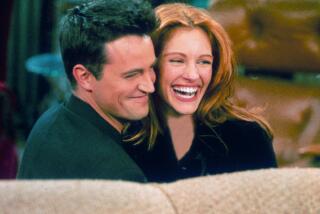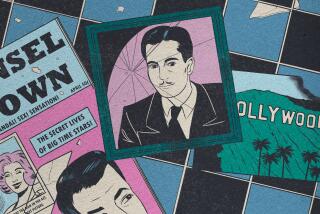HBO sees the light in Liberace biopic ‘Behind the Candelabra’
NEW YORK — When the news broke in 1987 that Liberace, the famously flamboyant pianist, was dead at age 67 with what his manager had claimed was anemia brought on by a watermelon diet but was, in fact, AIDS, it made front-page headlines around the country. It was a fitting tribute for a world-famous entertainer who just a few months earlier had played three weeks of sold-out shows at Radio City Music Hall.
A generation later, the man known as “Mr. Showmanship” is widely seen more as an avatar of kitsch than a true showbiz legend, someone whose sad death and campy image seem like relics of a less tolerant era. The Liberace Museum in Las Vegas, which once welcomed 450,000 people a year, closed in 2010, no longer able to attract enough visitors to keep the lights on.
But that’s set to change when “Behind the Candelabra,” starring Michael Douglas as a sexually voracious Liberace and Matt Damon as his coke-addled, much-younger lover, debuts May 26 on HBO. More than 13 years in the making, the film chronicles the unconventional relationship between the men: Scott Thorson, a former foster kid who reshaped his face with plastic surgery to look more like Liberace, later filed a multimillion-dollar palimony suit against the star. The case, eventually settled for $95,000, generated unwanted publicity for someone whose popularity with millions of suburban housewives depended on a carefully maintained façade of heterosexuality.
PHOTOS: Hollywood backlot moments
The chatter surrounding “Behind the Candelabra,” which arrives at a time when gay rights are at the forefront of public debate, is unusually intense. The last project that Steven Soderbergh, one of his generation’s most prolific and celebrated filmmakers, directed before going into supposed retirement from moviemaking, it landed at HBO after virtually every Hollywood studio passed on the fascinating but outré material. In a fitting professional coda for Soderbergh, the film will have its red-carpet premiere next week at the Cannes Film Festival, the same place his career took off 24 years ago when his provocative indie drama “Sex, Lies, and Videotape” won the Palme d’Or.
“I started out with a movie that’s about two people in a room, for the most part, and the heart of this movie is really two people in a room, although it’s a weird-looking room,” says Soderbergh in his Chelsea office, a paint-splattered space strewn with brushes, half-finished canvases and piles of magazine clippings — clutter related to his latest creative quest, learning to paint.
His self-imposed break has been anything but leisurely. He recently began writing “Glue,” a second-person murder-mystery novella, via Twitter, and plans to direct a miniseries based on John Barth’s epic satiric novel “The Sot-Weed Factor.”
Soderbergh also had tongues wagging last month after delivering the “State of Cinema” talk at the San Francisco Film Festival. In the impassioned address, he bemoaned an industry taken over by creatively bankrupt studio executives ignorant of cinematic history.
“Cinema as I define it, and as something that inspired me, is under assault by the studios,” he said, adding pointedly, “and, from what I can tell, with the full support of the audience.”
The tortuous development of “Behind the Candelabra” — and the way the studios all scurried from the material — surely contributed to his frustration.
The idea of making a film about Liberace, whose glittery shows featuring “Reader’s Digest versions” of classics by Beethoven and Chopin made him a top headliner in Las Vegas for decades, first occurred to the director on the set of “Traffic.” He quickly enlisted the involvement of that film’s star, Michael Douglas, but “couldn’t figure out what the narrative idea was going to be” until a friend steered him toward “Behind the Candelabra: My Life With Liberace,” Thorson’s 1988 tell-all. Suddenly, Soderbergh had his story.
“I didn’t want to do a biopic in the traditional sense. I wanted to go narrow and deep,” he says. “It’s Alice going down the rabbit hole. That’s a much more elegant way to get into Liberace’s life.”
From there, the pieces quickly fell into place: Jerry Weintraub would produce, Richard LaGravenese would write the script and Damon would play Thorson.
Economic fallout
But just as the project appeared to be gaining momentum, it stalled. Despite financing half of the initial draft, Soderbergh’s frequent studio partner Warner Bros. eventually passed on the project. According to the director, they concluded that even in a post-”Brokeback Mountain” landscape, with an Oscar-winning director and two bona-fide stars attached, “Behind the Candelabra” would never find a significant audience outside the gay community.
“None of us thought that was true, but there’s not a lot you can say to that. They’re just looking at the economics of it,” Soderbergh says.
Plan B — selling off foreign rights while looking for a domestic distributor to complete the last $5 million in financing — also fell apart, with studio after studio citing the same concerns about the film’s alleged niche appeal. “They just didn’t have the guts for the subject matter,” says the famously uncensored Weintraub by phone.
Soderbergh was baffled by the response.
“Obviously you were going to be able to cut the best trailer in the world because of all the fun visual stuff, and the subject matter and the people involved would get you the kind of attention that you just can’t buy,” he says.
Shut out of the studio system, Weintraub then called HBO, which had broadcast “His Way,” a documentary about his storied producing career in 2010. The network came on board the $20-million project without hesitation, and in something of an unusual arrangement, the film will air on HBO stateside but will be released theatrically overseas.
“It was an easy and immediate yes,” says HBO Programming President Michael Lombardo, who is, nevertheless, sympathetic to the constraints on his studio peers. “I can’t imagine anybody passed on this happily.”
Weintraub is somewhat less diplomatic: “It’s great, now I sit with my feet up and people tell me, ‘Geez, I wish I’d done that movie.’”
Soderbergh, never a cinematic purist, had no qualms about taking the project to the small screen — “Most of the stuff that I’m looking forward to seeing is on TV now,” he says.
The film’s stars are just as pleased with the outcome.
“I haven’t been involved in a movie where there’s been so much attention beforehand,” says Douglas, sitting for a joint interview with his costar in a hotel suite overlooking Central Park, a lavish setting Liberace himself might have appreciated.
With HBO, “You don’t have to defend your creative beachhead all the time,” Damon says. Still, like Soderbergh, he confesses to being surprised that the film scared off so many potential investors. “I thought someone like Harvey Weinstein, who’s made a career of making movies with more difficult subject matter, would have jumped at it.”
Douglas admits to some “initial insecurities” about playing a real-life figure for the first time in his 40-year career, particularly given the physical differences between himself and the barrel-chested Liberace, but the role was ultimately appealing.
“I play a lot of bad guys, so I said, ‘What fun to play a nice guy.’ He was a real giver,” says the actor, “until you crossed him.”
Thorson’s story
“Behind the Candelabra” hews closely to Thorson’s version of events: He was a foster kid of 17 when he met Liberace and became his live-in lover and sometime employee. By any estimation, theirs was an unconventional romance: At one point “Lee,” as he was known to friends, investigated the possibility of legally adopting Thorson, whose severe dieting developed into a nasty cocaine and prescription-drug addiction. (Thorson was not directly involved in the production.)
In Soderbergh’s telling, Liberace is a bundle of contradictions — at once funny, generous, controlling and narcissistic — and Thorson the wide-eyed naif seduced by all the glamour.
All of which suggests the possibility that “Behind the Candelabra” was not too gay for Hollywood but, rather, the wrong kind of gay — that is, not in keeping with the wholesome, unthreatening breed of same-sex relationships popular on TV these days, in shows such as “Modern Family.”
“The dynamic of the relationship that he had with Scott was very volatile,” Soderbergh says. “But it’d be the same story no matter what the gender: older powerful figure, younger beautiful person with no power. Add showbiz and you’ve got a pretty complex melange of elements.”
The film, rather than dwelling on the more eccentric aspects of Liberace and Thorson’s romance, delights in the mundane ones, portraying Lee and his “Baby Boy” as a loving couple prone to fighting over the same banal subjects — sex, careers, money — as many a husband and wife.
The actors chose to focus on selling the small details that made their relationship not just believable but relatable, like the familiar way they cuddle on the couch while watching television. The contrast between Liberace’s domestic routine and his extravagant lifestyle is a fertile source of humor, as when he and Thorson charge through their palatial Las Vegas penthouse, arguing about their barely existent social life. “Want me to invite Charo over for brunch?” Liberace asks, as a swarm of tiny dogs yap underfoot.
“The absurdity of their relationship to me made me think, ‘Well, all of our lives are absurd. We just think they matter because they matter so much to us,’” Damon says. “If you made a movie about all of our lives it, would probably seem as wonderful and tragic as this kind of story.”
Heightening the comedic effect are performances from Dan Aykroyd as Liberace’s manager and henchman Seymour Heller and especially Rob Lowe as Dr. Jack Startz, a plastic surgeon who gives Liberace a botched face-lift that renders him incapable of fully closing his eyelids (“This way you’ll be able to see people’s expressions when they see how fabulous you look!”).
Filming on location in recession-era Sin City also enhanced everyone’s appreciation for the absurd. “The hotel was so understaffed because I think they were bank-owned. You could get your room cleaned or you could take the ‘green option’ and they would give you a $5 paper token to go play the slot machines,” Damon recalls with a laugh.
Given the film’s high concentration of catty one-liners, rhinestone-studded G-strings and scenes set in foamy hot tubs, it’s easy to imagine how, in less capable hands, “Behind the Candelabra” might have become “Showgirls” for a new generation.
The key to avoiding such a pratfall was playing it straight. Says Douglas, the savvy veteran: “You never wink at the audience.”
More to Read
The complete guide to home viewing
Get Screen Gab for everything about the TV shows and streaming movies everyone’s talking about.
You may occasionally receive promotional content from the Los Angeles Times.






